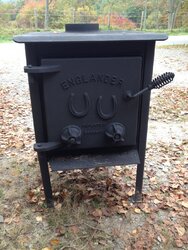I just purchased my first stove, an Englander. I'm not sure on the exact make of the stove, but here is a description: 20x20x20 firebox, solid cast iron door with two horseshoes on it and two air intake dials, supported by four dainty legs.
It will be professionally installed over a hardwood floor. Currently, there is no floor protection. I need to make it before they can install the stove.
Unfortunately, the port into my chimney is only 24 inches up from the floor. I will have to trim down the legs in order to install it. This means that I have 3 to 4 vertical inches in which to install some kind of floor protection.
Here is my current plan.
First, 26 gauge sheet metal laid directly on the floor.
Next, standard size cored concrete brick -- L 8in x W 3.6in x H 2.25in -- laid so the holes are horizontal. By laying the brick that way I can create air space by connecting the holes and hopefully that will create some cooling convection
____
IoooI (Brick that looks kinda like that) Here is a link: http://www.lowes.com/pd_10298-215-6...bricks&pl=1¤tURL=?Ntt=bricks&facetInfo=
Finally, mortar the brick together.
I pieced together this idea after browsing several sources: manuals for Englanders, NFPA guidelines, &c..
I'm not concerned about clearances; that has already been sorted. What I need is some sound advice on how I can protect my floor and also ways to reduce heat transference through the bottom of the stove.
I'm looking for anything, but please note I'm working on a dime, though I would never compromise safety by cutting corners.
Thanks
It will be professionally installed over a hardwood floor. Currently, there is no floor protection. I need to make it before they can install the stove.
Unfortunately, the port into my chimney is only 24 inches up from the floor. I will have to trim down the legs in order to install it. This means that I have 3 to 4 vertical inches in which to install some kind of floor protection.
Here is my current plan.
First, 26 gauge sheet metal laid directly on the floor.
Next, standard size cored concrete brick -- L 8in x W 3.6in x H 2.25in -- laid so the holes are horizontal. By laying the brick that way I can create air space by connecting the holes and hopefully that will create some cooling convection
____
IoooI (Brick that looks kinda like that) Here is a link: http://www.lowes.com/pd_10298-215-6...bricks&pl=1¤tURL=?Ntt=bricks&facetInfo=
Finally, mortar the brick together.
I pieced together this idea after browsing several sources: manuals for Englanders, NFPA guidelines, &c..
I'm not concerned about clearances; that has already been sorted. What I need is some sound advice on how I can protect my floor and also ways to reduce heat transference through the bottom of the stove.
I'm looking for anything, but please note I'm working on a dime, though I would never compromise safety by cutting corners.
Thanks



